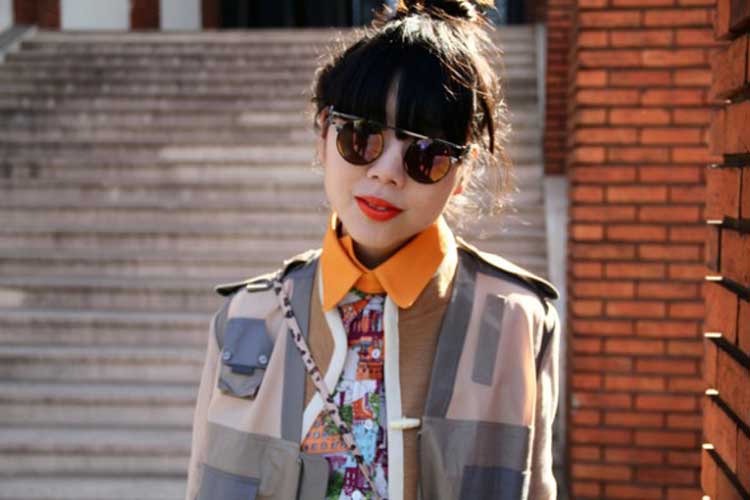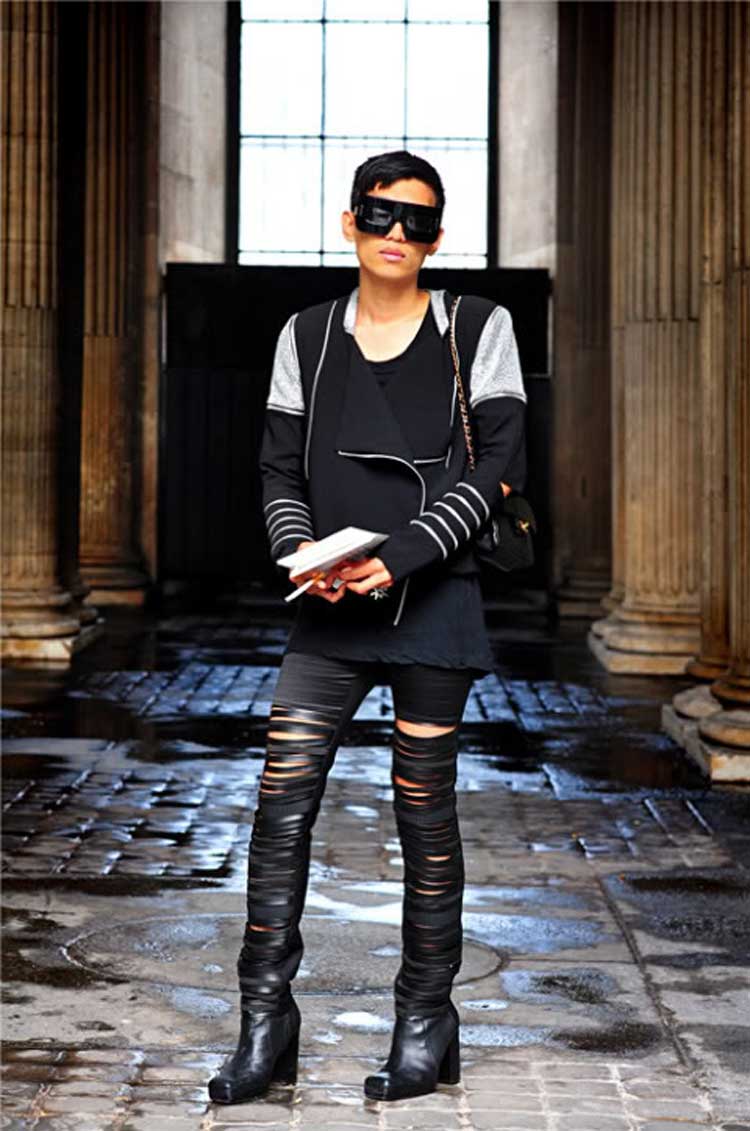Goodbye And Blog Off: The Ultimate Decline Of The Fashion Blogger
It’s rare, if not impossible, to visit a style blog in 2015 without scrolling through some native advertising. The phrase itself — which is interchangeable with “branded content” or “sponsored content,” although some will argue that there’s a difference between those three terms — means a lot of things to a lot of people.
That’s because, while fashion has been slow to adapt digitally in so many ways, it was one of the first group of marketers to embrace native advertising. When fashion bloggers emerged in the mid-2000s as the new influencers, brands developed “gifting” programs to seed their products. A handbag line, for instance, would send a top 10 blogger the latest style in hopes that she might write about it, or post a photo of it on her blog with a link back to the brand’s e-commerce site. It wasn’t so different than the business of celebrity placements, when brands give a star a pair of jeans or a leather jacket in hopes that she’ll wear it in a well-publicized paparazzi photo.

However, as blogs transformed from diaries to media properties, bloggers began asking for more. If they were going to post about the product, they wanted to be compensated for the post as well– in addition to the commissions they were making via affiliate links. Today, native advertising can be quite sophisticated. One of my all-time favourite examples of native advertising is a Juicy Couture-sponsored video, where stylist/Glamouraiblogger Kelly Framel interviews Carlyne Cerf de Dudzeele. This was soon after “In Vogue: The Editor’s Eye” had come out: Cerf de Dudzeele waxed on about why she loved track suits, and Framel — a genuine fan of the famous stylist — asked her the right questions. Sure, it didn’t save Juicy Couture from combustion, but it was a nice little Hail Mary moment. Nars’s video series with Garance Dore and the Man Repeller are more recent examples of likeable native advertising. Both Dore and TMR founder Leandra Medine are believable Nars customers, which makes the already fun videos all that more compelling.
But as more and more bloggers find their audiences fleeing URLs for other platforms — namely Instagram — and brands have begun to think harder about what they want from these partnerships, frustration has bubbled up on both sides. Bloggers argue that brands aren’t upfront about what they’re looking for in terms of tangible results, and brands argue that bloggers are unable to deliver anything tangible. The champagne might still be flowing, but the party is wrapping up for unhappy brands and frustrated bloggers.

Marketers have Complained that Bloggers often Fail To Complete
Brands are typically more vocal about dissatisfaction, probably because they’re the ones ponying up the cash. Marketers have complained to me that bloggers often fail to complete the agreed-upon list of “deliverables,” which can include a certain number of blog posts, click-throughs to an e-commerce site or unique visitors. Other brands say that even when a blogger completes the requirements, she often performs only the minimum. (Essentially that she didn’t try hard enough.) Given that these partnerships can cost upward of €25,000 for a series of sponsored posts, or more than €100,000 for a high-quality video series created by an A+ blogger, it’s understandable why brands expect a lot. “I have actually had to tell a blogger manager that their blogger needed to add more energy and life into her story. It was so boring that I had to rewrite it myself,” one brand manager told me. “I don’t want to rewrite anything. I value the voice of the blogger.”
But the bloggers aren’t always at fault here. A big part of the problem is that there have been very few parameters set around what makes a “successful” campaign. Blogger rates are all over the place, and brands have allowed inconsistency to become the status quo. Unlike a traditional banner-ad campaign — i.e., if the brand pays for 250,000 impressions, you’ve got to deliver 250,000 impressions — blogger campaigns are often as much about association as they are about click through, if not more so. An uncool brand thinks it will be elevated if it associates itself with a cool blogger. If a blogger’s audience is so far removed from that brand in the first place, the chances of the campaign working are small. What’s more, brands often dictate language for native advertising, which means that bloggers can’t even incorporate their personal flair into the campaign. “You can’t force someone to like [insert crappy brand here],” a Tier 1 blogger told me. “It can be an absolute nightmare.”
“It was sort of the Wild Wild West,” Rachel Tipograph, the founder and CEO of TIPO Entertainment, says of how brands and bloggers have volleyed in the past. “But that’s changing.” The former global director of digital and social media at Gap — who launched in 2011 Styld.by, a digital catalogue featuring Gap products styled by bloggers from more than 250 countries — says that both sides are getting savvier about what they need to do to make a partnership successful.
Some Bloggers have put the Onus on Themselves
Some bloggers have put the onus on themselves. “We pick brands that are aligned with the content we already feature,” says Kelly Cook, co-founder of Bag Snob, whose nearly decade-old site is now a full-fledged brand with a handbag collection that is available at retailers including Nasty Gal, Nordstrom and HSN. “We work really hard with them to come up with ideas that will incorporate our voice,” Cook says. The site recently partnered with Chico’s on a series: Bag Snob co-founder Tina Craig incorporated pieces from the collection into her everyday looks. “Those are the kinds of things that we do that have been really successful,” Cook says. “We never accept a campaign too far from what we do on the site every day.”
For bloggers, the key seems to be boundaries. “The power of no is really important,” says Erica Domesek, founder of D.I.Y.-driven site P.S – I Made This…. which launched over five years ago. Domesek decided early on to forgo traditional banner ads to focus on native advertising. (She prefers to call it “branded partnerships.”) “We just said no to a five-figure deal because it didn’t make sense for us. If you don’t believe in the brand, you should say no.”
Brands, on the other hand, need to know exactly what they want from the influencer before they ask for anything. “A misstep that brands have taken when it comes to native advertising is not assigning metrics to measure impact before launching the campaign,” says Tipograph. “It’s often an afterthought.”
The first part of that is to set goals internally. At Austin, Texas-based jeweller Kendra Scott, the hope is often to move product. The team works closely with affiliate marketing platform Reward Style to identify top bloggers who have an affinity for the brand. For instance, if the company is opening a store in a new city, the team consults with RewardStyle to see which local bloggers they should be contacting. Even something as simple as hosting showroom appointments during New York Fashion Week has worked for Scott. “It serves as market research,” says Lindsay Kaplan, who leads the brand’s affiliate marketing program. Indeed, working with bloggers has resulted in sold-out pieces. But it’s all about finding the right bloggers. “Some of our pieces aren’t going to resonate with the Man Repeller, and we understand that,” says Kaplan. “We think about who genuinely would love our product and would wear it. I spend a lot of time really thinking, ‘Will they wear this, or are they going to give it to their assistant?’”
For new Brooklyn-based men’s sneaker brand Greats, the key was to launch with the support of tightly knit, highly sceptical sneaker community. Co-founder and CEO Ryan Babenzien knew it was important to convince the community’s leaders — like Ronnie Fieg, owner of New York sneaker shop Kith — that the shoes were, well, great. (Babenzien even brought in #menswear style icon Nick Wooster to collaborate on a pair of slip-on sneakers.) “You can’t buy your way into this culture,” says Babenzien, who used to run entertainment marketing at Puma and K-Swiss before teaming up with long-time friend and shoe god Jon Buscemi on the vertically integrated line. “They will call you out in every way, shape or form.” Less than a year in, there is already a secondary market for Greats in Hong Kong, where kids are paying higher-than-retail prices for the shoes. (Greats doesn’t yet ship internationally.) “That couldn’t have happened if we didn’t start at the top of the [sneaker collector] pyramid,” Babenzien says.
What Each Other Can Do To Help Grow
But it’s not only about reaching the right people. It’s also about knowing exactly what you want from them in terms of metrics. New York-start-up Niche is attempting to standardize the process. Although it was called the “mini-William Morris for social media’s most influential stars” by Captial co-founder and CEO Rob Fishman insists that Niche is not an agency — the company does not take commissions on campaigns. Instead, it charges brands to access its database of influencers — including traditional bloggers, as well as Vine, Instagram, and YouTube stars — and also use its software tools to disseminate its media plans to the network of potential partners. For instance, say Samsung is looking for a group of Instagram stars to drive a certain number of followers to its own Instagram page. Samsung can input the plan into Niche’s system, and Niche will help Samsung find the right followers who will be able to successfully fulfil the campaign. It’s a metrics-driven system that encourages brands to cast a wide net for influencers with concentrated — i.e., niche — audiences instead spending their entire budget on one or two big-name media properties.
Brands are at Fault Here
Indeed, Niche encourages marketers to think beyond the same group bloggers they’ve been using for years. “Fashion and luxury [brands] were the first to jump on the so-called influencer bandwagon,” says Fishman. “But they’re stuck in their initial ways. Many are still looking at a five-year-old list of fashion bloggers. There’s a lot of room for luxury and fashion brands to innovate in this space.” Added one marketer, “Brands are at fault here. We paid bloggers their fees, gave them the words to write, and didn’t challenge the pricing or product. Bloggers should be treated as publishers and behave like publishers if they want to make it. Brands need to inspire the blogger and vice versa.”

















You must be logged in to post a comment.